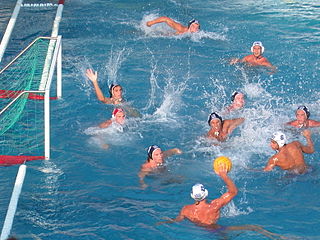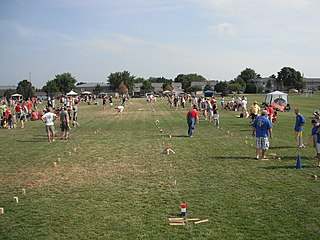Related Research Articles

Field hockey is a team sport structured in standard hockey format, in which each team plays with 11 players in total, made up of 10 field players and a goalkeeper. Teams must move a hockey ball around a field by hitting it with a hockey stick towards the rival team's shooting circle and then into the goal. The match is won by the team that scores the most goals. Matches are played on grass, watered turf, artificial turf, or indoor boarded surface.

Table tennis is a racket sport derived from tennis but distinguished by its playing surface being atop a stationary table, rather than the court on which players stand. Either individually or in teams of two, players take alternating turns returning a light, hollow ball over the table's net onto the opposing half of the court using small rackets until they fail to do so, which results in a point for the opponent. Play is fast, requiring quick reaction and constant attention, and is characterized by an emphasis on spin relative to other ball sports, which can heavily affect the ball's trajectory.

Tic-tac-toe, noughts and crosses, or Xs and Os is a paper-and-pencil game for two players who take turns marking the spaces in a three-by-three grid with X or O. The player who succeeds in placing three of their marks in a horizontal, vertical, or diagonal row is the winner. It is a solved game, with a forced draw assuming best play from both players.

Water polo is a competitive team sport played in water between two teams of seven players each. The game consists of four quarters in which the teams attempt to score goals by throwing the ball into the opposing team's goal. The team with more goals at the end of the game wins the match. Each team is made up of six field players and one goalkeeper. Excluding the goalkeeper, players participate in both offensive and defensive roles. It is typically played in an all-deep pool where players cannot touch the bottom.

Kubb is a lawn game where the objective is to knock over wooden blocks by throwing wooden batons at them. Kubb can be described as a combination of bowling and horseshoes. Play takes place on a small rectangular playing field, known as a "pitch". "Kubbs" are placed at both ends of the pitch, and the "king", a larger wooden block, is placed in the middle of the pitch. Some rules vary from country to country and from region to region, but the ultimate objective of the game is to knock over the "kubbs" on the opposing side of the pitch, and then to knock over the "king", before the opponent does. Games can last from five minutes to well over an hour. The game can be played on a variety of surfaces such as grass, sand, concrete, snow, or even ice.

Dodgeball is a team sport in which players on two opposing teams try to throw balls and hit opponents while avoiding being hit themselves. The objective of each team is to eliminate all members of the opposing team by hitting them with thrown balls, catching a ball thrown by an opponent, or inducing an opponent to commit a violation, such as stepping outside the court.
Canoe polo, also known as kayak polo, is one of the competitive disciplines of kayaking. The sport is also known simply as "polo" by its players and supporters.

Carrom is a tabletop game of Indian origin in which players flick discs, attempting to knock them to the corners of the board. In South Asia, many clubs and cafés hold regular tournaments. Carrom is commonly played by families, including children, and at social functions. Different standards and rules exist in different areas.

Shuffleboard is a game in which players use cues to push weighted discs, sending them gliding down a narrow court, with the purpose of having them come to rest within a marked scoring area. As a more generic term, it refers to the family of shuffleboard-variant games as a whole.

Flip cup is a team-based drinking game where players must, in turn, drain a plastic cup of beer and then "flip" the cup so that it lands face-down on the table. If the cup falls off the table, any player can return said cup to the playing field. Several flip cup tournaments have been held in the United States.

A goal kick is a method of restarting the play in a game of association football. Its procedure is dictated by Law 16 of the Laws of the Game.

Skully is a children's game played on the streets of New York City and other urban areas. Sketched on the street usually in chalk, a skully board allows a game for two to six players. A sidewalk is sometimes used, offering greater protection from vehicular traffic; however, the asphalt on a typical city street is smoother and provides better game play than a bumpy concrete sidewalk.

In American football, the specific role that a player takes on the field is referred to as their "position". Under the modern rules of American football, both teams are allowed 11 players on the field at one time and have "unlimited free substitutions", meaning that they may change any number of players during any "dead ball" situation. This has resulted in the development of three task-specific "platoons" of players within any single team: the offense, the defense, and "special teams". Within these three separate "platoons", various positions exist depending on the jobs that the players are doing.

Knock Out is a family tabletop game for two or more players published by the Milton Bradley Company in 1991.

Pichenotte refers to a family of several disk-flicking games, mostly French Canadian in origin, including crokinole, pitchnut, and North American carrom, which may sometimes be played with small cue sticks. Pichenotte is a Canadian French word meaning 'flick', which is derived from the European French word pichenette, also meaning 'flick'. These folk games are in the public domain, and are not subject to copyright like a commercial board game. Nor are they patented games. However, the names Pichenotte and Pitchnut are registered trademarks in the United States. The game community site Knipsbrat.com states that, like the German name Knipsbrat ('flicking-board'), "pichenotte is another name for crokinole" The Canadian game board collection at the Quebec Museum of Civilization in Quebec City includes both the square carrom-type board and the round crokinole-type game Crokinole is also called pichenotte throughout much of North America. Modern-day tournaments have been held as far apart as Tavistock, Ontario, and Santa Fe and Albuquerque, New Mexico.

Pitchnut is a wooden tabletop game of French Canadian origins, similar to carrom, crokinole and pichenotte, with mechanics that lie somewhere between pocket billiards and air hockey.

Cornhole is a lawn game popular in North America in which players or teams take turns throwing fabric bean bags at an inclined board with a hole in its far end. The goal of the game is to score points by either landing a bag on the board or putting a bag through the hole.
Family Game Night is an American television game show based on Hasbro's family of board games and EA's video game franchise of the same name. The show was hosted by Todd Newton. Burton Richardson was the announcer for the first two seasons; he was replaced by Stacey J. Aswad in the third season, and Andrew Kishino was hired for the fourth season. The 60-minute program debuted on October 10, 2010, on The Hub ; it was previewed on October 9, 2010, on its sister channel, TLC. Seasons 1 and 2 contained 26 and 30 episodes respectively. Seasons 3, 4 and 5 each contained 15 episodes. Season 2 premiered on Friday, September 2, 2011, with additional games being added. The games added to the second season included Cranium Brain Breaks, Green Scream, Ratuki Go-Round, Simon Flash, Operation Sam Dunk, Trouble Pop Quiz, and Spelling Bee. However games from the previous season were still kept.

The Challenge: Ride or Dies is the thirty-eighth season of the MTV reality competition series The Challenge, featuring alumni from The Real World, Road Rules, The Challenge, Are You the One?, Big Brother, Ex on the Beach, Survivor, Love Island, Ultimate Beastmaster, Prince Charming, The Mole Germany, Beauty & The Nerd and Exatlón Estados Unidos competing for a share at a $1 million prize. The season premiered on October 12, 2022, preceded by a launch special titled "Ready to Ride" which aired on October 10, 2022.
References
- ↑ "Space: Greg Burhop," The Chicago Sun-Times (video retrieved February 2, 2015). http://tv.suntimes.com/video/chicago-reader-space/space-greg-burhop%5B%5D
- ↑ "2014 ChiTAG Recap: What I Saw and Liked," The Game Aisle (December 1, 2014) http://www.thegameaisle.com/2014-chitag-recap/
- ↑ "The A.V. Club's Re-Gifting Guide, Or What We Got For The Holidays, Part One," The A.V. Club (November 26, 2013). http://www.avclub.com/article/the-av-clubs-regifting-guide-or-what-we-got-for-th-105917
- ↑ "Knock Down Barns - You Can Always Build Again".
- ↑ "The A.V. Club's Re-Gifting Guide, Or What We Got For The Holidays, Part One," The A.V. Club (November 26, 2013). http://www.avclub.com/article/the-av-clubs-regifting-guide-or-what-we-got-for-th-105917
- ↑ "Greg Burhop's Game of Barns in Pilsen," The Chicago Reader (November 8, 2013). http://www.chicagoreader.com/chicago/pilsen-loft-artist-walk-barn-wood-board-games/Content?oid=11484291
- ↑ "A Game of War and Wood," Thrillist (March 14, 2011). http://www.thrillist.com/entertainment/knock-down-barns_online-shops_websites
- ↑ "The Game Aisle Recaps ChiTAG 2014," The Dice Tower (December 10, 2014)
- ↑ "Chicago Toy & Game Fair: Instagram site" (November 2, 2014). http://instagram.com/p/udaYbmkhWW/?modal=true